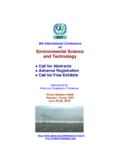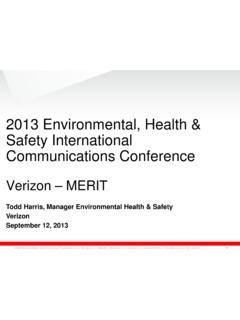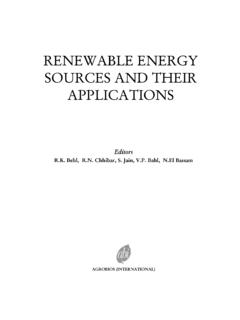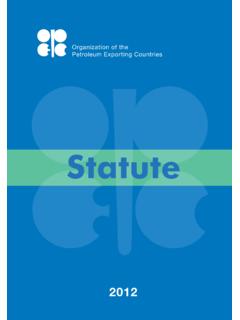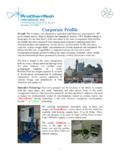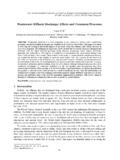Transcription of Estimating Cleanup Costs for Oil Spills
1 #168, 1999 international Oil Spill ConferenceESTIMATING Cleanup Costs FOR OIL SPILLSD agmar Schmidt EtkinOil Spill Intelligence ReportCutter Information , Massachusetts, : The factors that affect Cleanup cost arecomplex and interrelated. Each spill involves a unique setof circumstances that determine Cleanup cost . Estimating auniversal per-unit Cleanup cost is essentially meaninglesswithout taking into consideration factors such as locationand oil type, which can profoundly influence Costs .
2 Thispaper examines the host of factors that impact Cleanup costin an effort to more accurately assess per-unit Cleanup cost -estimation model, based on an analysis of cost datain the Oil Spill Intelligence Report (OSIR) international OilSpill Database (a 38-year record of over 8,600 oil spillsworldwide) is presented as an alternative to a universalper-unit cost Costs associated with cleaning up an oil spill arestrongly influenced by the circumstances surrounding thespill including: the type of product spilled; the location andtiming of the spill; sensitive areas affected or threatened;liability limits in place; local and national laws; andcleanup strategy.
3 The most important factors determining aper-unit amount (either per-gallon or per-tonne) cost arelocat ion and oil t ype, and possibly total spill amount. Thecomplex interrelationships of these factors and the mannerin which they are influenced by other factors is shown inFigure 1: Factors determining per unit oil spill Cleanup experts agree that the most important determinantof Cleanup Costs is location. Location itself is a complexfactor involving both geographical and political and legalconsiderations.
4 The timing of a spill, both seasonally anddiurnally ( , tide cycles), can profoundly influence thenature and sensit ivit y o f the geographical lo cat ion. In somecircumstances, timing can also impact the political andlegal regime under which the spill geographical location and timing can have aprofound effect on the logistics of a spill response equipment into a remote location ormobilizing crews during a winter storm can greatly increasethe complications of a response, and thus the political regime under which the spill occurs can alsoaffect the ultimate Cleanup cost .
5 Spill responses in theUnited States, for example, are notoriously more expensivethan Spills in other locations, according to many analysts,even when eliminating the Costs of natural resource damageassessments. This can be attributed to a large extent on theresponse requirements stipulated by the Oil Pollution Actof 1990 (OPA 90) (Figure 2).Figure 2: Average Cleanup cost per tonne spilled (in 1997 $), based on analysis of oil spill cost data in the OSIRI nternational Oil Spill social culture that places a high value onenvironmental preservation can also have a large influenceon Cleanup Costs .
6 Especially with regard to wildliferehabilitation and intensive shoreline Cleanup coverage often increases social pressure to returnareas impacted by an oil spill to their former pristine condition even when the site has no extraordinarysignificance from a conservation point of view. Especiallyin the United States, fear of future litigation often impelsspillers to mount massive response operations atconsiderable expense to dispel any notions of irresponsibility.
7 In some cases, public and governmentpressure for the responsible party to undertake radical andexpensive Cleanup procedures may not always be in thebest interest of environmental protection, even if it is well-intentioned. In these cases, public pressure for the spiller to do something to quickly restore the environment may bemotivated more by aesthetics than by true environmentalconcerns. While a beach might look clean after aggressivecleanup efforts, the procedures employed may actuallyresult in more environmental damage than the spilled resourcesProximity to sensitive resources is another essentialfactor in determining response Costs .
8 Even a relativelysmall spill in an inopportune geographical location ortime, such as one near a sensitive marshland during a birdmigration, near a beach at the height of tourist season, neara fish farm, or in the vicinity of a desalination plant, can beexpensive. Cleanups near a sensitive resource need to bethorough and conducted to the satisfaction of local andnational authorities and property owners to avoid legalaction. Spills in many areas in Asia often threaten localaquaculture calling for more thorough (and expensive) Cleanup oilingThe proximity of the oil spill to the shoreline is one of themost important factors impacting Cleanup Costs .
9 Oil spillsthat impact shorelines are considerably more expensive toclean up than ones which can be dealt with offshore (Figure3). When an oil spill occurs, the most importantgeographical factors to consider are: Did the oil spill in a location where it is likely to hitany shoreline? Is the oil spill close enough to shoreor under the influence of currents and windconditions that make it likely that the oil will impactthe shoreline? What type of shoreline is involved? How close is the shoreline to inhabited areas?
10 What value does the population place on theshoreline or resources likely to be impacted?Figure 3: Average Cleanup cost depending on shoreline impact (in 1997 $), based on analysis of oil spill costdata in the OSIR international Oil Spill typeThe type of oil spilled is another significant factor indetermining Cleanup Costs (Figure 4). The more persistentand viscous the oil the more widespread the contaminationand the more difficult removal will be. The composit ionand physical properties of the oil will affect the degree ofevaporation and natural dispersion, as well as the ease ofremoval.
